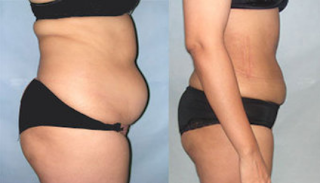BREAST LIFT
Many women, particularly those who have had children, will notice that their breast tissue will droop and “deflate” following breast-feeding. This phenomenon is not limited to mothers, however, as changes in weight as well as hormone fluctuations can cause these same issues. Some women, in fact, are born with breasts that may not be as “perky” as they would like. Many patients who complain of this breast deflation, or “breast ptosis” in medical terms, benefit from an elevation of the breast tissue, known as a breast lift or
mastopexy
Breast lift achieves the following:
Brings the breast to a more attractive position
Reduces the size of Areola
Helps the breast to become more perky .
There are several ways to go about providing true or apparent lifting of the breast tissue.
Wise Pattern Breast Lift:
The standard and effective technique to lift the breast is known as a Wise pattern mastopexy Classically, breast lifts were done through a pattern similar to classical breast reductions, resulting in a scar around the nipple, down the center, and underneath of the breast, which you can think of as an anchor type of configuration. While this operation works well for many patients, it provides a lot of scarring, and can, in certain patients, give rise to a breast that lacks proper projection. Efforts were subsequently made to try and improve the deficiencies of this operation, and a plastic surgeon named Dr. Lejour developed a breast surgery that eliminated the scar under the breast and improved postoperative breast form. This is called the vertical mastopexy.
Vertical Breast Lift:
The vertical mastopexy has become one of the mainstays of the breast lift here in my practice. This operation works well for most women who do not have massive breasts, and allows some degree in reduction of the size of the breast if this is what you are looking for. Alternatively, the vertical breast lift can be combined with a breast implant in order to increase the breast size. In either situation, the scars from this vertical breast lift look like a lollipop- around the nipple and down the center of the breast. The concept behind the vertical mastopexy is the rearrangement of the breast tissue itself to a higher position, rather than creating a skin sling to suspend the breast tissue. This breast tissue rearrangement is felt to give a more pleasing shape and a longer lasting result.
Benelli Breast Lift:
For those patients that require only minimal lifting and who may be adverse to the longitudinal scar of the vertical breast lift, an alternative may be what is called a purse-string, or Benelli mastopexy. This operation is performed by resection of an eccentric area of skin around the nipple, which can be thought of as an oval shaped doughnut where more skin is resected above the nipple than below it. Following a small amount of dissection in the breast tissue to strengthen the breast lift, this incision is closed with a purse-string suture that “cinches” the breast envelope centrally and upward to provide a lift. The scar resulting from this breast lift operation is only around the nipple along the transition between the pigmented areola and the skin of the breast. This operation does have the limitation of lifting the breast tissue only one to two centimeters, however, and so only patients with minimal ptosis may be candidates for this procedure.
The Use of Breast Implants With Your Breast Lift:
With any breast lift procedure, the result may be enhanced with the ancillary use of a breast implant to increase volume and fullness.
A breast implant may be used with the classic breast lift, the vertical breast lift, or the Benelli breast lift procedure. Placement of large breast implants during these procedures is discouraged because of the following safety issue. When dissection of the breast tissue is performed in order to achieve a higher and more youthful appearance, careful attention must be given to the blood flow to the breast tissue that is being rearranged. Large implants placed under this dissection can put undue tension on the lifted breast tissue, causing compromise of the nipple. breast implants that are not excessively large may be used at the time of your initial breast lift operation as a single procedure. Discussion regarding your individual anatomy and expectations will allow a plastic surgery plan to be tailored to your specific situation. The quality of scar can also be improved if your surgeon is committed and places deep suture to avoid widening of the scars





